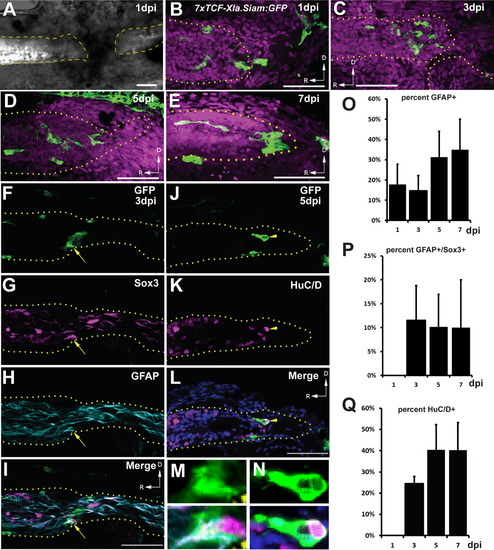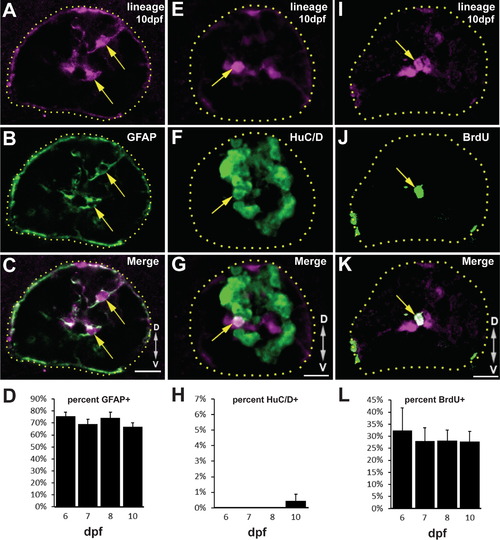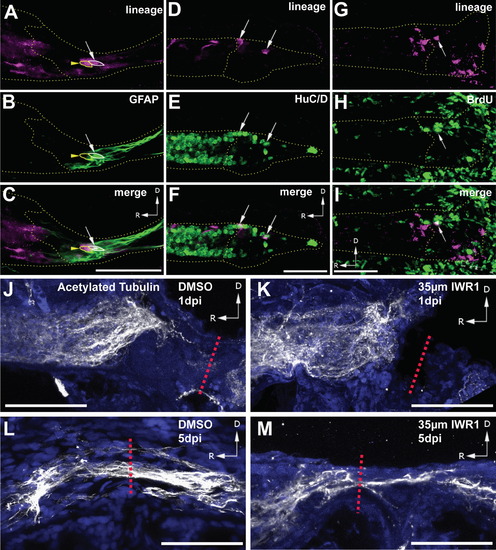- Title
-
Wnt/▀-catenin signaling Is required for radial glial neurogenesis following spinal cord injury
- Authors
- Briona, L.K., Poulain, F.E., Mosimann, C., Dorsky, R.I.
- Source
- Full text @ Dev. Biol.
|
Wnt reporter expression after SCI. (A) Lateral view of a transected spinal cord at 1 dpi showing loss of neurons (white, labeled by elavl3:EGFP) at the injury site. (B?E) The 7xTCF-Xla.Siam:GFP Wnt reporter (green) is expressed in the regeneration blastema from 1 to 7 dpi. Magenta channel is nuclear staining. (F?I) Wnt reporter-expressing cells express GFAP and Sox3 at 3 dpi (arrow). (J?L) Other reporter-expressing cells are HuC/D+ neurons at 5 dpi (arrowhead). Blue channel is nuclear staining. (M,N) High-magnification views of co-labeled cells from panels (I and L). Percentage of GFP+ cells co-expressing GFAP, GFAP and Sox3, and HuC/D. Image in (A) is merged from fluorescent and brightfield channels obtained with a compound microscope. Images in (B?N) are single confocal slices from lateral views of whole-mounted larvae. Scalebars=50 Ám, dashed/dotted lines outline the spinal cord, and D/R arrows indicate dorsal and rostral, respectively. For (O?Q), n=5 sections at each timepoint; error bars=SEM. |
|
Tg(gfap:CreERT2,CY)zd16 labels a quiescent population of radial glia. (A?D) Following 4-OHT treatment, most mCherry+ cells remain GFAP+ (arrows) through 10 dpf. (E?H) In contrast, very few mCherry+ cells express HuC/D (arrow) beginning at 10 dpf. (I?L) After incubation in BrdU from 4 to 5 dpf, there is no significant expansion of the BrdU-labeled subset of mCherry+ cells (arrow). All images are single confocal slices of 12 ÁM transverse cryosections. n=25 sections from 5 animals at each timepoint; error bars=SEM; scalebar=10 ÁM, dotted lines outline the spinal cord, and D/V arrows indicate dorsal and ventral, respectively. |
|
Representative images of gfap:CreERT2-labeled progeny in the regenerating blastema. (A?C) At 5 dpi one mCherry+ cell is GFAP+ (arrow), while a neighboring cell is GFAP (arrowhead). (D?F) At 5 dpi, multiple HuC/D+ progeny (arrows) are present. (G?I) At 3 dpi progeny labeled by BrdU incubation from 4 to 5 dpf (arrow) are present. (J and K) At 1 dpi, both DMSO and IWR1-treated larvae show a lack of axons, labeled with anti-acetylated tubulin, crossing the injury site (red dashed line). (L and M) At 5 dpi, DMSO-treated larvae show robust axon recrossing, while in IWR-treated larvae only a few axons are present at the injury site (red dashed line). Images (A?I) are single confocal slices from lateral views of whole-mounted larvae, dotted lines outline the spinal cord and blastema. Images (J?M) are maximum intensity Z-projections from lateral views of whole-mounted larvae, blue channel is nuclear staining. Scalebars=50 Ám. |
Reprinted from Developmental Biology, 403(1), Briona, L.K., Poulain, F.E., Mosimann, C., Dorsky, R.I., Wnt/▀-catenin signaling Is required for radial glial neurogenesis following spinal cord injury, 15-21, Copyright (2015) with permission from Elsevier. Full text @ Dev. Biol.



